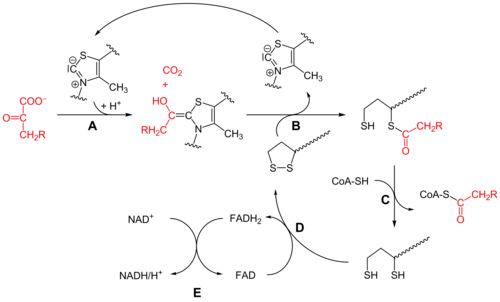10: Pyruvate Dehydrogenase Links Glycolysis to Krebs Cycle
- Page ID
- 167347
Aerobic respiration begins with the entry of the product of glycolysis, pyruvate, into the mitochondria. The mitochondria is an organelle in the cell. It is considered the "powerhouse" of the cell. Pyruvate is transported there via pyruvate translocase. For each initial glucose molecule, two pyruvate molecules will enter the mitochondria. Pyruvate, however, is not the molecule that enters the citric acid cycle. Prior to entry into this cycle, pyruvate must be converted into a 2-carbon acetyl-CoenzymeA (acetyl-CoA) unit.
Pyruvate dehydrogenase is a multi-enzyme complex that uses three enzymes:
- E1: Pyruvate dehydrogenase which uses thiamine pyrophosphate (TPP) as its cofactor.
- E2: Dihydrolipoyl transacetylase which uses lipoamide as its cofactor.
- E3: Dihydrolipoyl dehydrogenase which uses flavin adenine dinucleotide (FAD) as its cofactor.
The conversion of pyruvate into acetyl-CoA is referred to as the pyruvate dehydrogenase reaction. It is catalyzed by the pyruvate dehydrogenase complex (PDH). This process produces one NADH electron carrier while releasing a CO2 molecule. This step is also known as the link reaction or transition step, as it links glycolysis and the citric acid cycle. Of course, as two pyruvates result from glycolysis, two acetyl-CoAs are produced as are 2 NADH molecules.
Note: Prosthetic groups are molecules that are covalently bonded to an enzyme.
The net reaction of converting pyruvate into acetyl coA and CO2 is:

The Process
This is a five step process.
- Step A: Pyruvate is decarboxylated by pyruvate dehydrogenase with help from TPP.
- Step B: The reactive carbon (between the N and the S of the five membered ring) of the TPP is oxidized and transferred as the acetyl group to lipoamide (which is the prosthetic group of the dihydrolipoyl transacetylase). This forms hydroxyethyl-TPP. An H+ ion is required for the intermediate to give off CO2.
- Step C: E2 (dihydrolipoyl transacetylase with cofactor lipoamide) oxidizes hydroxyethyl- to acetyl- and then transfers acetyl- to CoA, forming acetyl-CoA.
- Step D: Acetyl CoA was made in the previous step. However, the process is incomplete. The E2 is still attached to the acetyl CoA molecule. So, E3 (dihydrolipoyl dehydrogenase) oxidizes the thiol groups of the dihydrolipoamide back to lipoamide.
- Step E: As a side reaction, NAD+ becomes reduced to NADH.

Supplemental Resources
Citric Acid Cycle (aka Krebs Cycle): http://virtuallabs.stanford.edu/other/biochem/TCA.swf
Krebs Cycle (aka Citric Acid Cycle): http://johnkyrk.com/krebs.html
Contributors
CK-12 Foundation by Sharon Bewick, Richard Parsons, Therese Forsythe, Shonna Robinson, and Jean Dupon.
Allison Soult, Ph.D. (Department of Chemistry, University of Kentucky)
Zubay, Geoffrey. Biochemistry. New York: Macmillan Publishing Company, 1988.
Boyer, Rodney. Concepts in Biochemistry. New Jersey: John Wiley & Sons, Inc, 2006


